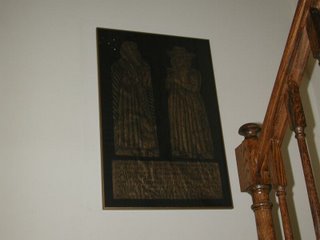 This is a horrible picture, but subsequent tries were even worse. It's the worst artwork my house contains. I made this brass rubbing back in 1976 or 1977 in the basement of a church just off Piccadilly Circus. I think it cost me 6 pounds sterling for the permission and materials. I made many others like it, but from smaller brasses, so I'm really glad that my parents didn't frame and give away this one to any of their friends or our relatives. It's the last one of its kind in my family. They framed it for me, and I hung it on the stairwell landing for over 10 years before it fell off and crashed to the landing, and onto the bannister one day while I was a t work.
This is a horrible picture, but subsequent tries were even worse. It's the worst artwork my house contains. I made this brass rubbing back in 1976 or 1977 in the basement of a church just off Piccadilly Circus. I think it cost me 6 pounds sterling for the permission and materials. I made many others like it, but from smaller brasses, so I'm really glad that my parents didn't frame and give away this one to any of their friends or our relatives. It's the last one of its kind in my family. They framed it for me, and I hung it on the stairwell landing for over 10 years before it fell off and crashed to the landing, and onto the bannister one day while I was a t work.I had to take it to a framer to have it reframed. There was nothing they could do to repair the small tear in the corner that happened as a result of the crash/bang fall from the wall. But they did a superb job of reframing it, in a gold-tone frame that matches the gold colored wax better than the original frame ever did.
I really like this piece of crap art, not so much because I made it myself, but for the inscription below the images of the dead people. It reads:
Mr. John Gvnther & his wife Alice being fvll as of yeares so of bovnty & charity are gathered to their fathers in peace. Shee was bvried 18 Martii A.O. Dni. 1626 aged 86 yeares. Hee was bvried at Kyntbvry in the covnty of Berks with the like monvment 2 Ianavaryii A.O. Dni. 1624 aged 89 yeares. Ios plat ar eorvndm, gener et ex execr hoc posvit.
To me, this gives an excellent language lesson in English regarding its evolution over the centuries. It's easily translatable to me (just replace every v with a u), and even Kyntbvry is recognizable as being what we call Canterbury. The Roman element is still very much alive in terms of spelling. No doubt the "hee" and "shee" are phonetic spellings that were perfectly acceptable as correct back in the 17th century.
There was no OED back in those days. Alice Gunther was buried on March 18, 1626, and her husband, John Gunther, was buried in Canterbury on January 2, 1624. Alice was 86 and John was 89. That much is obvious to me. I don't really need a translator for it. But I find the language fascinating. Although English is a Germanic language, it's clear that there's a Roman influence that lingered long after the Druids, Angles, Saxons, and Picts.








2 Comments:
Actually, I kinda like that piece.
It's a piece of my childhood teen years, so I'm I'm fond of it even beyond the language lesson.
Post a Comment
<< Home